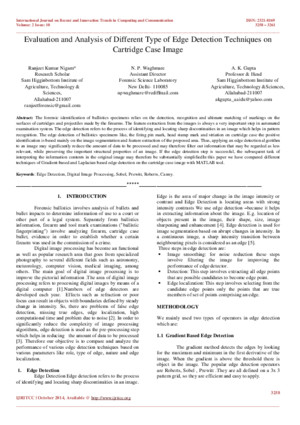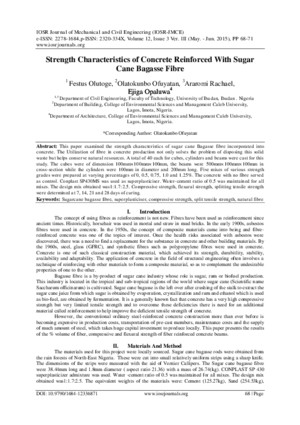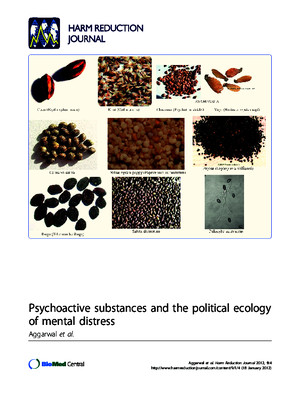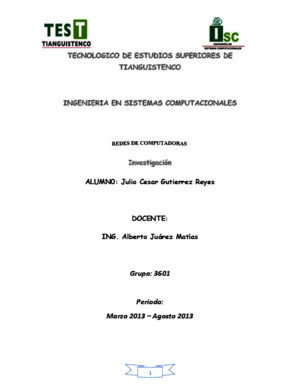In Vitro Evaluation and Testing for the Antagonistic Activity of Trichoderma Isolates Against Coffee Wilt Disease Fusarium Xylarioides
There is document - In Vitro Evaluation and Testing for the Antagonistic Activity of Trichoderma Isolates Against Coffee Wilt Disease Fusarium Xylarioides available here for reading and downloading. Use the download button below or simple online reader.
The file extension - PDF and ranks to the Documents category.
Tags
Related
Comments
Log in to leave a message!
Description
Download In Vitro Evaluation and Testing for the Antagonistic Activity of Trichoderma Isolates Against Coffee Wilt Disease Fusarium Xylarioides
Transcripts
INTERNATIONAL JOURNAL OF TECHNOLOGY ENHANCEMENTS AND EMERGING ENGINEERING RESEARCH, VOL 3, ISSUE 06 4 ISSN 2347-4289 Copyright © 2015 IJTEEE In-Vitro Evaluation And Testing For The Antagonistic Activity Of Trichoderma Isolates Against Coffee Wilt Disease (Fusarium Xylarioides) Solomon Legesse School of Agriculture, Animal and Range Science Course Team, Madawalabu University, Bale-Robe, Ethiopia Email: solofaxumgmailcom ABSTRACT : Coffee arabicais the key cash crop and top mainstay of the Ethiopian economy and requires sustainable production methodsCoffee wilt disease is one of the reasons for the reduction in coffee productivity as well in the livelihoods of millions involved in cultivation, processing, marketing, and export of coffee The major causative agent of coffee wilt disease is Fusariumxylarioides Trichodermaspecies are known for the effective control for this particular pathogen In the present study;Trichoderma species were isolated from the soil sample taken from Jimma and the antagonistic efficiency of Trichoderma isolates against Fusariumxylarioideswas confirmed, using dual culture method Trichodermaisolates significantly inhibited the mycelial growth of Fusariumxylarioidesranging from 8308% - 8114%, after 6 to 10 days of incubation at 25 o Trichoderma isolates showed successful antagonism against the test pathogen (Fusariumxylarioides) Key Words : Coffee wilt disease , Fusariumxylarioides, Trichoderma, Dual culture, antagonistic test INTRODUCTION The word "coffee" comes from the name of a region of Ethiopia where coffee was first discovered – Kaffa Ethiopia is the home and cradle of biodiversity of Arabica coffee seeds More genetically diverse strains of C arabicaexist in Ethiopia than anywhere else in the world, which has lead botanists and scientists to agree that Ethiopia is the centre for srcin, diversification, and dissemination of the coffee plant [3][1]Coffee is vital to the economy of East and Central Africa, providing amajor source of foreign exchange earnings and, as a cash crop, supportingthe livelihoods of millions involved in cultivation, processing, marketing,and export Ethiopia is well known as the country of srcin of “Buna” (coffee in Amharic) but it is also one of the poorest countries in the sub Saharan region, with aper capita income of about US 100 [12], which is one of the lowest in Africa The estimated coffee production area (2% of total cultivated land) in Ethiopia is in the range 320,000-700,000 ha; although there are a potential 6 million ha of cultivable land suitable for coffee production [5]Tracheomycosis or vascular wilt disease of coffeeor coffee wilt disease (CWD) is caused by a fungus(Fusariumxylarioides) which also has a sexualstage (Gibberellaxylarioides) The pathogen wasfirst described in the Democratic Republic ofCongo in 1948, although the disease had alreadybeen identified for two decades During the 1940sand 1950s, the disease became a serious problem for Robusta coffee[4] Coffee wilt disease, attributed to Fusariumxylarioides, has caused losses to coffee production in Africasince 1927, but has been largely contained through the use of host resistanceand in some instances wide-scale sanitation practicesThe disease is responsible for a reduction in the production of coffee beans and is also accompanied by severe damage and death of millions of coffee bushes [9] Coffee wilt disease (CWD) is present in four African countries: Democratic Republicof Congo (DRC), Uganda, Tanzania and Ethiopia, and absent from the other countriessurveyed (Rwanda, Côte d‟Ivoire and Cameroon) [8] Biological control, ie, the antagonism and eventual killing of plant pathogens by other living organisms, which are themselves not harmful to the plants, could present an attractive alternative for combating wilt disease Species of the anamorphic genus Trichoderma(teleomorph: Hypocrea, Ascomycota) have been proven as effective biocontrol agents of soil-borne plant diseases Trichodermawould be especially suitable for combating coffee wilt disease becausemany of its species are rhizosphere competent, and the coffee roots are the first target for the attack by pathogens In support of this hypothesis, Trichodermaspecies have already been applied successfully to suppress Fusariumspecies causing Asparagus root rot, bean root rot, and carnation wilt [11] Trichoderma species are free-living fungi that are common in soil and root ecosystems Recent discoveries show that they are opportunistic, a virulent plant symbionts;/+6, as well as being parasites of other fungi At least some strains establish robust and long-lasting colonization of root surfaces and penetrate into the epidermis and a few cells below this level They produce or release a variety of compounds that induce localized or systemic resistance responses, and this explains their lack of pathogenicity to plants These root – microorganism associations cause substantial changes to the plant proteome and metabolism Plants are protected from numerous classes of plant pathogen by responses that are similar to systemic acquired resistance and rhizobacteria-induced systemic resistance Root colonization by Trichodermaspp also frequently enhances root growth and development, crop productivity, resistance to abiotic stresses and the uptake and use of nutrients[4] This research work isthen aimed at evaluating and testing antagonistic activity of Trichoderma isolates against Fusariumxylarioides(coffee wilt disease) in in-vitro condition INTERNATIONAL JOURNAL OF TECHNOLOGY ENHANCEMENTS AND EMERGING ENGINEERING RESEARCH, VOL 3, ISSUE 06 5 ISSN 2347-4289 Copyright © 2015 IJTEEE MATERIALS AND METHODS Source of soil sample and the plant pathogen The soil which is used to isolate the biological control agents is taken from Jimma, while isolated culture of Fusariumxylarioides, which were known to be the major causative agent of coffee wilt disease, was obtained from Addis Ababa University mycology laboratory Serial dilution preparation Isolation of biological control agents from the soil was done by serial dilution agar plating method First of all the soil sample was grinded in to fine particles there by 10g of soil is weighed In serial dilution agar plate methods, 10g of soil sample was suspended or agitated in 90ml distilled water to make microbial suspension Serial dilutions of 10 -2 , 10 -3 , 10 -4 , 10 -5 and 10 -6 were made by transferring a volume of 1 ml from 10 -1 serial dilution in the flask into 10 -2, , from which another 1ml is taken to 10 -3 , and the rest of the dilution were made in the same manner Inoculation A dilution 10 -3 and 10 -4 were selectively used for inoculation 1ml of 10 -3 and 10 -4 dilutions were added to sterile labeled Petri dishes (triplicate for each dilution) which contain 20ml of the sterile, cool, molten Czapek-Dox agar media Dilutions were spreaded on to specific agar plates and incubated in an inverted position for 5 days at 25 0 C Anumber of colonies of fungal antagonists on dilution plates were picked and purified on potato dextrose agar media Identification of Trichoderma Isolates Morphological characterization and identification of Trichoderma isolates was done according to [2] Antagonistic test Dual culture method was employed to evaluate the antagonistic potential of Trichodermaisolates The experiment was arranged in three replicatesAdditional plates having only the test isolates were used as controlA 5 mm diameter mycelial disc from the periphery of 5 days old culture of bio-agents (Trichoderma isolates) were placed on the opposite side of the test pathogen (Fusariumxylarioides) isolates on Potato Dextrose Agar PDA) All plates were incubated at 25 o C The mycelial growth inhibition was measured after 6 , 8 and 10 days of inoculationIn so doing the percentage of inhibition was calculated, in relation to growth of the control, by the following formula: % inhibition = (C-T) ×100 Table 1 In-vitro evaluation of Fusariumxylarioides mycelia growth inhibition by Trchoderma isolates over control Where, „C‟ is radial growth measurement of the pathogen in thecontrol platesand „T‟ is radial growth of the pathogen in the experimental plates RESULTS Characterization of Trichoderma isolates Trichoderma strains often can readily be identified to the genus level by a distinctive morphology that includes rapid growth, bright green or white conidial pigments andconidiophores[2] Microscopic examination of our isolates showed that whiteconidiophores Further confirmation of the isolates was also made by bright green mycelia with rapid growth Where, 1 AUT1= Addis Ababa university Trichoderma isolate 2 AUT2= Addis Ababa university Trichoderma isolate 3 AUT3= Addis Ababa university Trichoderma isolate The above table (Table 1) contains the continuous record of Trichoderma inhibition during the dual culture growth The daily record shows a decrease in inhibition zone as day of incubation period increase This is because; Trichodermaisolates can directly affect mycelia or survival propagules of Fusariumxylarioides through production of toxic secondary metabolites, formation of specialized structures, and secretion of cell wall-degrading enzymes [13] Figure 1: Mean mycelial growth inhibition of Fusariumxylarioides by Trichoderma isolates 0051152AUT1AUT2AUT3 Day 6Day 8Day 10 Trichoderma isolates Mean Average % of inhibition over control AUT1 1523 8308 AUT2 1697 8114 AUT3 1687 8126 INTERNATIONAL JOURNAL OF TECHNOLOGY ENHANCEMENTS AND EMERGING ENGINEERING RESEARCH, VOL 3, ISSUE 06 6 ISSN 2347-4289 Copyright © 2015 IJTEEE Trichoderma isolates Mycelia growth inhibition on PDA after days of incubation in cm Control 6 th 8 th 10 th Mean AUT1 9 2 16 15 17 AUT1 9 15 12 12 13 AUT1 9 17 15 15 157 AUT2 9 18 17 17 173 AUT2 9 15 16 15 153 AUT2 9 2 18 17 183 AUT3 9 18 17 17 173 AUT3 9 18 17 17 173 AUT3 9 17 16 15 16 The above graph reveals that, the mean value growth of Fusariumxylarioides shows a decrease as day of incubation period increase (Fig 1) Table 2 Mean and average percentage of Fusariumxylarioidesmycelial growth inhibition over control This table (table 2) illustrates the mean and average percentage inhibition of Fusariumxylarioides by Trichoderma isolates According to the result, AUT1 shows highest average percentage inhibition (8308%), while AUT2 shows lowest average percentage inhibition (8114%) DISCUSSION Antagonistic effect based on the dual culture experiments showed that, Trichodermaisolates significantly inhibited the mycelial growth of Fusariumxylarioidesranging from 8308%-8114%, after 6 to 10 days of incubation at 25 o C No inhibition zones were visibly observedHowever, all the Trichoderma isolates have shown over growth on the test fungus in in-vitro evaluation But for comparison, isolate AUT1gave the highest inhibition percentage valueof 8308% whereas isolate AUT2 inhibited 8114% which is the last inhibition after 10 days of incubation period at 25 o C In a similar study [11], have indicated that in vitro evaluation of all isolates of Trichodermatested were able to inhibit the mycelial growth of Fusariumxylarioidesbetween 55% and 76%[13], have also indicated that, Trichodermaisolatestested were able to inhibit the mycelial growth of Fusariumxylarioidesof the test pathogen from 66 to 8060% Areporte of percent inhibitonby [6] shows that 66% and 71% for Trichodermaharzianumand Trichodermavirideagainst Fusariumxylarioides In similar studies [10] also documented that Trcodermaharzianumagainst Drechsleratriticirepentisgave the highest inhibition capacity of 978% in dual culture analysis And also [7] reported that Trichodermaspecies significantly inhibited Drechsleratriticirepentiscolony growth between 50 and 74% utilizing dual culture techniques on potato dextrose agar CONCLUSION Biological control agent which is the use of microbial antagonists to suppress plant pathogens is a good method of controlling plant pathogens The in vitro evaluation of dual culture technique exhibited that the mycelial growth of the pathogenic fungus is suppressed by the Trichodermaisolates Trichoderma isolates shows successful antagonism against Fusariumxylarioideswhich is the causative agent of coffee wilt disease Therefore, Trichoderma species are used as important components of integrated pest management REFERENCES [1] Bayetta, B (2001) Arabica coffee breeding for yield and resistance to coffee berry disease (Colletotrichumkahawae sp nov) Dissertation, University of London, Imperial College Wye, U K [2] Bissett, J (1991) A revision of the genus TrichodermaIIInfrageneric classificationCan J Bot 69 : 2357-2372 [3] Fernie L M (1966) Some impressions of coffee in Ethiopia Kenya Coffee 31: 115-121 [4] Fraselle J (1950) Observations préliminairessurunetrachéomycosede Coffearobusta Bull Agricole du Congo Belge, 41: 361-372 [5] Harman, E G, Howell, R C, Viterbo, A, Chet, I and Matteo, L(2004) Trichoderma species opportunistic, avirulent plant symbiontsNature Rev Mic 2 : 43-56 [6] Mekuria, T, Neuhoff, D and Köpke, U (2004) The status of coffee production and the potential for organic conversion in Ethiopia Conference on International Agricultural Research for Development, Berlin, October 5-7 [7] NegashHailu (2007) Isolation, Identification of Fusariumxylarioidesfrom Southern Ethiopia and its response to Fungal Biocontrol AgentsMsc Thesis, Addis Ababa University [8] Perello, A, Monaco, C, Simond, M, Sisterna, M and Bello, G (2003) Biocontrol efficacy of Trichodermaisolates for tan spot of wheat in Argentina Crop Prot 22 :1099 – 1106 [9] Phiri N and Baker, PS (2009) Coffee Wilt in Africa Final Technical Report CAB International [10] Rutherford, A M, 2006 Current knowledge of coffee wilt disease, a major constraint to coffee production in AfricaThe American PhytopatholSoci 6 :663-666 [11] Susanto, A, Sudharto, P and Purba, R (2005) Enhancing biological control of basal stem rot















